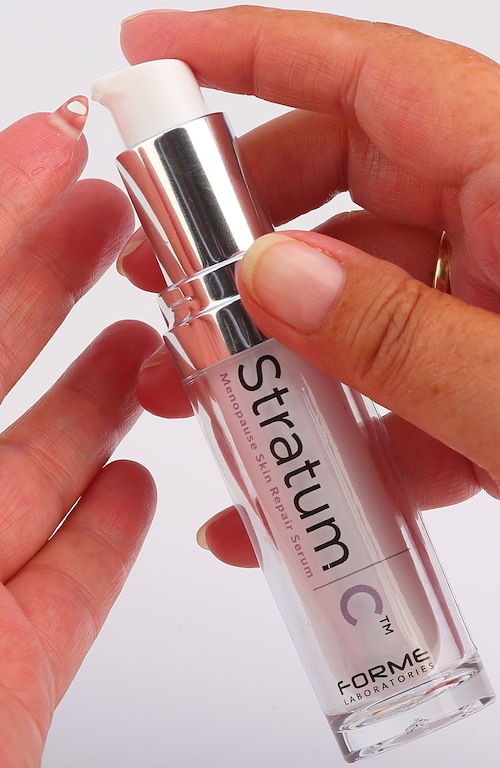The promise of the menopause skin cream
Have you heard about Stratum C? Evidently, this wonder cream, formulated specifically for menopause skin, has been shown to relax facial muscles AND build collagen, while simultaneously moisturizing, promoting elasticity and providing a radiant glow. And, it has science to back it up, you know, an unpublished study conducted in a whopping 10 subjects.
Moreover, as the product restores that youthful glow that menopausal women so crave and erases signs of aging, it will only set you back $195. The thing is, to obtain the best results, evidently you need to use it from the start of menopause symptoms until the last symptom occurs. That’s an average of 10 years.
Want to know what’s in this magical cream?
“In addition to the collagen stimulating peptides Stratum C was formulated to contain Hyaluronic Acid to hydrate and moisturise the skin even into the lower levels of the dermis. Finally to combat existing wrinkles we included a muscle tightening ingredient that has been shown in clinical trials to reduce existing deep wrinkles by 45% in just one month.The base moisturiser in Stratum C is based on natural luxurious products well known to the beauty industry including Jojoba Oil, Seaweed and Apricot Oil the latter being a good source of Vitamin A and E which are also lost during the Menopause.”
In women in particular, aging is accompanied by a loss of estrogen, which has been linked with as great as a 30% loss of collagen in the dermis (the thick, sturdy layer of connective tissue that comprises about 90% of the skin’s thickness) within the first five years of menopause. Collagen, which is the most abundant protein in the body, is responsible for skin’s durability and strength. As it declines, skin starts to sag and wrinkles form. Oh, happy day!
There is absolutely no doubt that one of the peptides contained in this new cream and serum stimulates production of collagen and there are published studies demonstrating that. The question is, however, whether or not a cream or serum contains enough of the ingredient to perform the way that it claims to perform. And quite honestly, a majority of dermatologists will tell you that while a cream can help promote moisture and is necessary, it won’t reverse the ravages of environmental exposure built over the years. Estrogen, for example, has been shown to increase collagen, help the skin retain water and promote elasticity, yet its ability to reverse the effects of aging remain questionable.
I am all for looking as good as we possibly can at any age. A lot of that has to do with genes, sunscreen, diet and prior exposure. And I will be last person to judge someone who wants to drop a bunch of money on the promise of youth. Me? I’d rather save my dollars for something that is proven to work and until that happens, I’ll follow the directions of my dermatologist and preserve what I have got the best I can.
Buyer beware. This one sounds way too good to be true.
Read MoreIn the Flash: June/July Roundup
Can you believe that it’s August already?! I feel as though the Summer has flown by and that I’ve been unconsciously busy for most of it. Since it may be the case that between work, vacations and celebrations you’ve missed the best of June and July, I wanted to pull some posts from the recent archives that demand your attention.
Without further ado, here’s what you’ve missed, In the Flash…
- Who put the men in menopause…men! Who would have thunk it. But evolutionary research suggests that men and male proclivity for younger mates in order to perpetuate the race created menopause. Seems a bit out there but there you have it!
- Worried about skin aging? Wear sunscreen! And try to get more sleep. Yup, this time I’ve dished up two separate factors that will age your skin quicker than you can apply that expensive anti-aging moisturizer. And you absolutely need to pay attention!
- Next time you need that caffeine fix, be mindful of where you are going to get it. I’m Re-spilling the beans on coffee and caffeine and the news may cause you to think twice before dropping that money on a cup of espresso.
- Guyside: Does my butt look big in this world? Flashfree’s got a new columnist and he’s a male who’s not afraid to show his feminine side what it feels like to be a man. Ladies – you definitely want to direct your men to this monthly column written by the incredible Bob LeDrew.
- Is estrogen safe? Has the nail come out of the estrogen coffin? Or is the pro-hormone team trying once again to pull a fast one? You’ll want to read this piece for the latest news on the hormone front.
Wednesday Bubble: Skin Cancer Awareness – You and Your Car
 According to recent estimates, skin cancer accounts for half of all cancers in the U.S. More than 3.5 million cases of basal or squamous cell skin cancer are diagnosed yearly; these types of skin cancer are generally found on the base or surface of the skin and can be cured if treated early enough. Melanoma — the most deadly of all skin cancers that affects the melanocytes, or cells that create skin pigmentation — accounts for more than 2/3rds of skin-cancer related deaths; this year, more than 76,000 cases are expected to be diagnosed. And, one person dies of melanoma in this country every 57 minutes.
According to recent estimates, skin cancer accounts for half of all cancers in the U.S. More than 3.5 million cases of basal or squamous cell skin cancer are diagnosed yearly; these types of skin cancer are generally found on the base or surface of the skin and can be cured if treated early enough. Melanoma — the most deadly of all skin cancers that affects the melanocytes, or cells that create skin pigmentation — accounts for more than 2/3rds of skin-cancer related deaths; this year, more than 76,000 cases are expected to be diagnosed. And, one person dies of melanoma in this country every 57 minutes.
In other words, skin cancer is not something to mess around with.
If you are like me, a child of the 60s and 70s, catching rays meant baby oil and tin foil. My father, who is in his late 80s, grew up on the beach and has spent the last 20 years having patch after patch of skin cancer removed. His body is a veritable skin cancer harvester, and he has even been permanently disfigured due to a botched procedure to freeze cancer cells below the surface of the skin on his nose. He’s lucky; he’s still alive and catching those cancers early enough.
I can’t emphasize it more: wear sunscreen. Moreover, wear it when you are in the car!
A study in the June issue of the Journal of the American Academy of Dermatology demonstrates that sun protection while driving is sorely lacking, despite the fact that driving evidently constitutes the largest percentage of total time spent outdoors, more than exercise or gardening. Moreover, on average, the majority of people in this country spend 80 to 100 minutes of their day in their cars.
Mind you, this is a retrospective study, which means that the researchers look back at events that have already occurred; this case, they mailed surveys to 675 patients who had previously attended a surgical clinic for skin cancer. Of all of these patients, 90% had a history of at least one type of skin cancer and 30, of malignant skin cancer.
Ironically? A majority did not believe that they needed to wear sunscreen while driving regardless of whether or not the windows were open or closed, although 53% of people with a prior history of skin cancer thought that they should wear it with the windows open. Real life use of sunscreen was different; about a third of these people reported wearing sunscreen “most of the time,” while only 15% used it while driving. What’s more, about a third of the people who reported wearing sunscreen most of the time while in a vehicle did not apply it to their arms or hands.
Additionally, having tinted car windows didn’t seem to provide additional protection. An equal percentage of people with or without tinted windows developed non-malignant skin cancer (85%); the only difference was the side of the body the skin cancer resided.
Here’s what you need to know:
- Automobile glass does not contribute to skin cancer equally. Important factors include the type of glass, the degree of tinting and the presence or absence of lamination or UV-absorbing film.
- In one study, clear auto glass transmitted 62% of UV radiation whereas dark-tinted glass transmitted 11.4%.
- Windshields are made from laminated glass that allows, on average, 2% transmission of UV radiation. Conversely, your side and rear windows are typically non-laminated and allow up to 80% of UV radiation. This means that the shoulder, arm and hand closest to the window needs to be protected because they are receiving the highest exposure to UV rays.
There are some issues with this study; for example, it relied on recall and and patients may have overestimated or even underestimated real exposure. However, the message is quite clear: wear sunscreen when you drive.
p.s. May is skin cancer awareness month. Pass it on: wear sunscreen, period.
Read MoreNewsFlash! Can fish oil supplements help prevent skin cancer?
Omega-3s. When it comes to a buzz, it keeps growing louder and louder. And while I’ve observed the buzz between a reduction in skin cancer risk and fish oils for some time now, the studies showing positive benefit have been done in rats, which makes it difficult to apply findings to humans. That is, until now.
Researchers from the University of Manchester in England published a paper in the American Journal of Clinical Nutrition online this past January that explored the first study of omega-3s and skin cancer in humans. And while the study is small, it’s a first step towards what could possibly be very good news for many .
For context, UV radiation (UVR) causes the majority of non-melanoma skin cancers and the incidence of these cancers continues to rise in particular, among white and lighter skinned individuals. Researchers believe that sunlight suppresses the ability of cells and the immune system to fight off skin cancer and infection, therefore allowing them to proliferate and cause cancer. This is one reason that people with diseases that suppress the immune system are more prone to developing cancer. However, there is some evidence that diets that are rich in omega-3 fatty acids are associated with reduced risk of skin cancer, perhaps as a result of how they benefit immunity.
The study included 73 women between the ages of 18 and 60 who sunburned easily with no or very little ability to tan. These volunteers either took 4 g of omega-3s daily (70% EPA, 10% DHA) or a placebo pill for 12 weeks and were exposed daily to 8, 15 or 30 minutes of simulated sunlight (via a special light machine). The results? Among women exposed to sunlight for 8 or 15 minutes a day, taking omega three supplements appeared to shut down immune suppression by as much as 50%. However the greater the sun exposure, the less effect omega-3s had, as the researchers did not observed the same protection among women who had 30 minutes of sun exposure daily .
The researchers say that the findings are important because most people apply sunscreen inadequately and don’t wear it daily. So, boosting daily omega-3 intake may potentially help protect against skin cancer, so long as sun exposure is limited. Still, bear in mind that omega-3s are not replacements for sunscreen; rather, consider them part of your armor against cancer. Meanwhile, we need bigger studies to see if these initial findings can be borne out in larger numbers of people.
Stay tuned. Whatever you do, omega-3s are good for your heart and perhaps, for you skin as well!
Read MoreNewsflash…Before you ‘D’ know the facts. New recommendations from EMAS.
Vitamin D. Lately it’s been touted as the cure-all for all that ails. From bone health and diabetes, to cancer and infections, vitamin D is the go-to supplement. But, do you really need it? And how much should you be taking on a daily basis?
Vitamin D levels are reportedly low in women undergoing menopause and because it is necessary to maintain bone health, there is no question that it’s in great demand by our bodies. This is especially true of fair skinned individuals, women, and people who live at higher altitudes. In fact, research shows that a number of factors can influence how the body synthesizes or produces Vitamin D, including altitude, time of year (e.g. winter) time of day, amount of exposed skin at any given time, skin pigmentation, extensive use of sun protection (i.e. sunscreen, protective clothing, shade) and air pollution). However, the more news that comes out about vitamin D, the more confusion abounds as to its true benefits and how much you should be taking.
Some of that much needed detail is provided in a recent statement issued by the European Menopause and Andropause Society. Rather that put you to sleep with all the details, here a few highlights that sets current knowledge about vitamin D on the correct path:
- Although there have been a ton of studies on vitamin D, linking it to outcomes and risks and benefits in a variety of conditions, evidence for its benefit is strongest in terms of bone/skeletal health.
- Osteoporosis is very common in postmenopausal women leading to increased fracture risk. It appears that adequate levels of vitamin D may help preserve bone structure and contribute to the function of muscles. In studies, women with the lowest vitamin D blood levels were shown to have the highest fracture risk.
- Healthy postmenopausal women can insure that their body’s levels of vitamin D are optimized by exposing skin to the sun, 15 minutes at a time at least three to four times a week during Spring, Summer and Fall. This does not include artificial UV exposure from tanning booths.
- Experts recommend that women supplement sun exposure with no more than 800 to 1,000 IU of vitamin D supplements a day.
- If you are someone at risk for low vitamin D levels, you should see your doctor or health care practitioner for screening to achieve optimal vitamin D levels.
- Women who are obese, have conditions that prevent proper absorption of nutrients (for example, HIV or chronic diarrhea) or have liver or kidney issues need to have tailored vitamin D recommendations.
And the news about over supplementation and toxicity? First of all, you can never get vitamin D toxicity through sunlight (although as we know, too much sun can lead to other problems, like skin cancer). And, toxicity issues have been linked to dosages above 50,000 IU over several months time. Last, women with cancer are likely to convert vitamin D in the body faster, so need lower levels. Again, this calls for monitoring by a health practitioner.
Overall, before you ‘D.’ know the facts. These recommendations are a great start.
Read More










